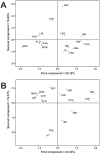Introducing the Algerian mitochondrial DNA and Y-chromosome profiles into the North African landscape
- PMID: 23431392
- PMCID: PMC3576335
- DOI: 10.1371/journal.pone.0056775
Introducing the Algerian mitochondrial DNA and Y-chromosome profiles into the North African landscape
Abstract
North Africa is considered a distinct geographic and ethnic entity within Africa. Although modern humans originated in this Continent, studies of mitochondrial DNA (mtDNA) and Y-chromosome genealogical markers provide evidence that the North African gene pool has been shaped by the back-migration of several Eurasian lineages in Paleolithic and Neolithic times. More recent influences from sub-Saharan Africa and Mediterranean Europe are also evident. The presence of East-West and North-South haplogroup frequency gradients strongly reinforces the genetic complexity of this region. However, this genetic scenario is beset with a notable gap, which is the lack of consistent information for Algeria, the largest country in the Maghreb. To fill this gap, we analyzed a sample of 240 unrelated subjects from a northwest Algeria cosmopolitan population using mtDNA sequences and Y-chromosome biallelic polymorphisms, focusing on the fine dissection of haplogroups E and R, which are the most prevalent in North Africa and Europe respectively. The Eurasian component in Algeria reached 80% for mtDNA and 90% for Y-chromosome. However, within them, the North African genetic component for mtDNA (U6 and M1; 20%) is significantly smaller than the paternal (E-M81 and E-V65; 70%). The unexpected presence of the European-derived Y-chromosome lineages R-M412, R-S116, R-U152 and R-M529 in Algeria and the rest of the Maghreb could be the counterparts of the mtDNA H1, H3 and V subgroups, pointing to direct maritime contacts between the European and North African sides of the western Mediterranean. Female influx of sub-Saharan Africans into Algeria (20%) is also significantly greater than the male (10%). In spite of these sexual asymmetries, the Algerian uniparental profiles faithfully correlate between each other and with the geography.
Conflict of interest statement
Figures



References
-
- Newman JL (1995) The peopling of Africa. A geographic interpretation. Yale University Press, New Haven and London
-
- Wendorf F, Schild R, Close AE, Schwarcz HP, Miller GH, et al.. (1994) A chronology for the middle late Pleistocene wet episodes in the eastern Sahara. In: Bar-Yosef O, Kra RS (eds) Late Quaternary Chronology and Paleoclimates of the Eastern Mediterranean. Journal of Radiocarbon in Association with the American School of Prehistoric Research, Tucson. pp 147–168
-
- Brett M, Fentress E (1996) The Berbers. Blackwell Publishers, Oxford
-
- Murdock GP (1959) Africa: Its peoples and their culture history. McGraw-Hill, New York
-
- Rando JC, Pinto F, Gonzalez AM, Hernandez M, Larruga JM, et al. (1998) Mitochondrial DNA analysis of northwest African populations reveals genetic exchanges with European, near-eastern, and sub-Saharan populations. Ann Hum Genet 62: 531–550. - PubMed
MeSH terms
Substances
LinkOut - more resources
Full Text Sources
Other Literature Sources
Miscellaneous

